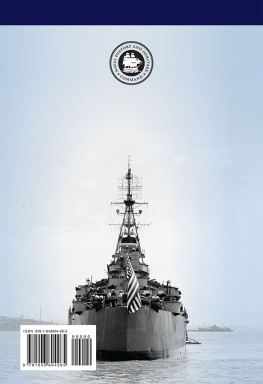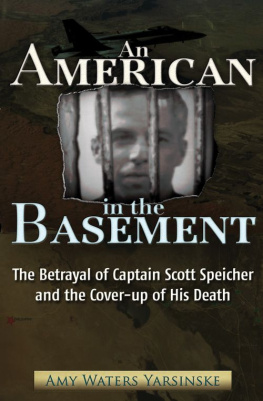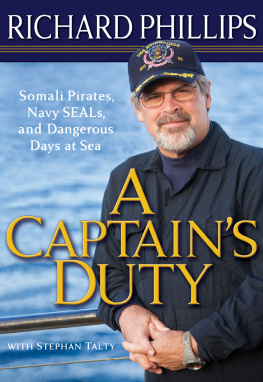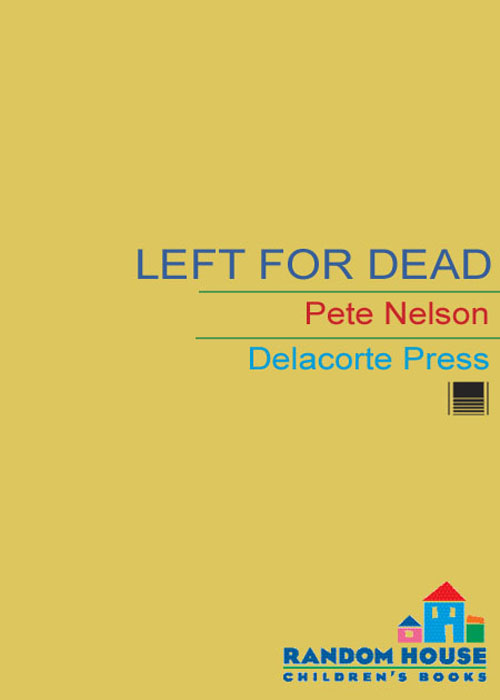
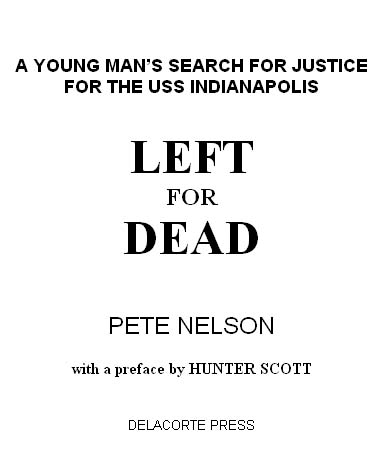
Contents
To the final crew of the USS Indianapolis (CA-35)
Pete Nelson
Preface
I was standing in front of my history fair project, surrounded by a cluster of men in their mid-seventies and -eighties. Their families, children and grandchildren were also gathered around. These men had one thing in common: They were all survivors of the USS Indianapolis. I had developed a special appreciation for these men and what they had done in World War II. I had learned to appreciate these veterans who had sacrificed so much to ensure that a generation that had not been alive when they served could enjoy liberty.
It was July 1997, and we were in the Westin Hotel in Indianapolis. The second floor was crammed with men, women and children of all ages. There were display cases lined up along the walls, all pertaining to World War II or the Indianapolis. Everywhere I went, I was surrounded by ten or twenty men. They all had communicated with me in some fashion over the course of the past year, and each wanted to personally tell me his story of his four nights and five days in the ocean. To a man, when their story reached a point at which they talked about shipmates and friends dying, their eyes teared up, and I could sense the deep sadness and the emotional scars each of them carried.
Maybe that is why so few of them had ever shared their personal stories and dark memories until I started asking questions. Many of these men had never told their family members what they shared with me. I am not sure why I was chosen to be the guardian of their stories, but I accepted the task with the same honor and commitment these men had shown in sharing their tales with me. Perhaps they thought I might represent their last chance to tell someone what had been haunting them for more than fifty years. Each man I talked to thanked me for what I was doing for them and their captain.
Let me tell you a little bit about what got me involved with the survivors of the USS Indianapolis. My name is Hunter Scott. I am sixteen years old and in the eleventh grade at Pensacola High School. For the past two years I was elected class president and Young Republicans president, and I am an active athlete as well. I am the center on the football team and a pole-vaulter on the track team. I attend First Baptist Church of Pensacola and am the lead guitarist in the churchs youth band and a sax player in the worship band. Playing my guitars and hunting, fishing and surfing are some of my favorite activities.
When I was eleven years old, in the summer of 1996, I was getting ready to enter middle school and the sixth grade. On an afternoon that was unusually hot even for Florida, my dad and I were watching his favorite movie, Jaws. In one part of the movie, Captain Quint and the other two guys have had a little too much to drink and are telling stories about how tough they are. One guy asks Captain Quint what that tattoo is on his arm. Quint tells the story of the Indianapolis. As I listened to the story of men being attacked by sharks, I was fascinated. I had heard what Quint said before, but this was the first time I had really listened.
When the scene was over, I stood up and asked my dad if it was a true story. My dad said, Yes, and please move from in front of the TV. I asked him again to tell me more about it. He said he didnt know much about the incident other than that it was a true story. Being a school principal, he gave an answer I should have expected: If you want to know more, I will take you to the library and you can check out a book on the USS Indianapolis.
I was looking for a topic for a history fair project, and after hearing the story of the ship, I knew I had my subject. The theme for that year was Triumph and Tragedy, and this story had both. Little did I know that what started as a simple history project would consume the next five years of my life and provide an experience very few are ever afforded. Nor did I realize that this project would allow me to work with some of the most powerful people in Washington, D.C., and would embroil me in a legal battle with one of the oldest and most prestigious institutions in America, the United States Navy.
My dad was doing research for his dissertation that summer and decided to take me to the University of West Floridas library to teach me how to do research. I must admit, a fishing trip with Dad would have been my first preference, but dads love teaching certain life lessons to their sons, and that days life lesson happened to be research. On our first trip he took me down to the World War II section of the library. He pulled out a large stack of books, placed them on the table, showed me how to use an index and set a legal pad on the table. He told me he was going upstairs and would be back in one hour. I was to write on the legal pad summaries of what I found and where, and when he returned we would discuss what I had discovered.
When he got back he looked disappointed to see only four or five lines written on my legal pad. He gave me a solemn look and I heard a familiar question: What have you been doing for the last hour? I told him there was almost nothing in any of the books about the USS Indianapolis. I could tell he was a little skeptical about my answer. With an I will show you how to do this look, he sat down with the books himself.
In the end he told me there was something wrong. He wanted to know why the greatest sea disaster in naval history was not thoroughly discussed in the history books. He took me upstairs and showed me how to do a microfiche search of 1945 newspapers. We found some information about the USS Indianapolis and the court-martial of Captain McVay, who was blamed for the sinking, but still very few facts. An Internet search also provided little useful information. Why was the greatest naval wartime loss of life not thoroughly discussed in detail in history books, in old newspapers or on the Internet?
My history teacher had told me that interviews with individuals who had lived through historical events were a primary resource and very valuable. I decided to try to locate survivors of the Indianapolis. My mom suggested putting an ad in the Gosport, a local navy newspaper, requesting information about the Indianapolis and survivors. A response to the ad helped me locate survivor Maurice Glenn Bell, who lived in Mobile, Alabama. I called and set up an interview in his home.
Mr. Bell was a wonderful man, and his story was even more chilling than the scene in Jaws. I felt a lot of compassion for Mr. Bell after all he had been through. He believed that Captain McVay had been done an injustice. After I interviewed Mr. Bell, my project became a mission. I decided to try to right a wrong that had been done more than fifty years before. Mr. Bell showed me his Purple Heart, told me about his job as a lookout on the ship, and explained how his faith in God had helped him survive the ordeal. He also gave me a USS Indianapolis hat. Most importantly, he gave me a list of the remaining survivors. Of the 317 men who survived the sinking, 154 were still alive. In 1996 these men ranged in age from sixty-nine to ninety-two.
I started by writing to forty of the survivors whose names I recognized from the sources I had read, asking for additional information. The response was tremendous. Many of these men sent personal memorabilia, pictures, letters and original navy documents. Many survivors decided for the first time in their lives to write about what had happened to them during their five days and four nights surrounded by sharks and death.
Next page


